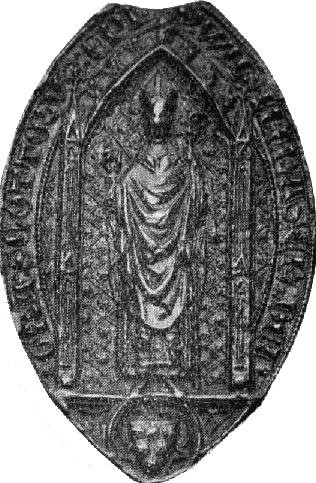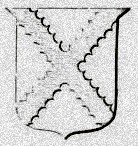Related Research Articles
William de Sancto Claro, or simply William Sinclair, was a 14th-century bishop of Dunkeld. He was the son of Amicia de Roskelyn and Sir William Sinclair, Baron of Roslin. He was the brother of Sir Henry Sinclair, baron of Roslin. After the death of Bishop Matthew de Crambeth in 1309, William was elected to the bishopric. The following year, on 24 February 1310, William was one of twelve Scottish bishops to swear fealty to King Robert the Brus. However, king Edward II of England had his own candidate in mind, John de Leck. William went to the Holy See, where his election was contested by the said John. The diocese of Dunkeld lay vacant for three years. Pope Clement V appointed Cardinal James, cardinal deacon of St George in Velabro, to judge the issue. However, the issue was more or less resolved when, on 22 May 1311, John de Leck was promoted to the Archbishopric of Dublin. When John de Leck took over the see of Dublin on 20 July, he retired from the dispute. The pope then declared William's election canonical, and sent him to Cardinal Berengar Fredol, bishop of Tusculum, in order to be consecrated. On 3 February 1313 king Edward II issued a safe-conduct to William, clearly indicating that the bishop was planning to arrive in England on his way back to Scotland, however Edward demanded cooperation in political matters as a condition. William became a frequent witness to King Robert's charters, but that did not prevent Bishop William, on 24 September 1332, being present at the coronation of Edward Balliol. Bishop William attended the latter's parliaments. William died on 27 June 1337, and was buried in the choir of Dunkeld Cathedral.

William de Lamberton, sometimes modernized as William Lamberton, was Bishop of St Andrews from 1297 until his death. Lamberton is renowned for his influential role during the Scottish Wars of Independence. He campaigned for the national cause under William Wallace and later Robert the Bruce. As Bishop of St Andrews, the most powerful seat in Scotland, Bishop Lamberton along with Bishop Robert Wishart of Glasgow conducted the coronation of Robert the Bruce as King Robert I. Lamberton would go on to have a vital role in the formulation of the Declaration of the Clergy 1310 and the Declaration of Arbroath which would lead to Scottish Independence.
Robert de Stuteville was Bishop-elect of St Andrews and Bishop of Dunkeld. Robert was dean of Dunkeld as early as 1253, when he was elected to the bishopric of St Andrews on 28 June that year. His election was opposed by the king, Alexander III, and by the bishopric's Céli Dé chapter. The prior and the canons sent Robert to Rome, but a delegation of the king, including Abel de Golynn, was also sent, and the result was that Robert's election was quashed.

William Fraser was a late 13th century Bishop of St Andrews and Guardian of the Kingdom of Scotland. Before election to the bishopric, he had been and Royal Chancellor of King Alexander III of Scotland and dean of Glasgow. He was elected to the bishopric on 4 August 1279, and confirmed in the position the following year by Pope Nicholas III

Thomas Stewart was an illegitimate son of King Robert II of Scotland. In 1380, Avignon Pope Clement VII provided Thomas with the Archdeaconry of the Bishopric of St. Andrews, as well as the canonry of Stobo in the Bishopric of Glasgow. In 1389, the king petitioned and obtained for Thomas from the Pope the right to hold the deanery of the Bishopric of Dunkeld along with his other offices, and in 1393, the Pope provided a canonry in the Bishopric of Brechin. In this period, Archdeacon Thomas obtained a Bachelor of Canon Law at the University of Paris.
Jocelin was a twelfth-century Cistercian monk and cleric who became the fourth Abbot of Melrose before becoming Bishop of Glasgow, Scotland. He was probably born in the 1130s, and in his teenage years became a monk of Melrose Abbey. He rose in the service of Abbot Waltheof, and by the time of the short abbacy of Waltheof's successor Abbot William, Jocelin had become prior. Then in 1170 Jocelin himself became abbot, a position he held for four years. Jocelin was responsible for promoting the cult of the emerging Saint Waltheof, and in this had the support of Enguerrand, Bishop of Glasgow.
Walter Capellanus was an important cleric and politician in the Kingdom of Scotland during the reigns of kings William the Lion and Alexander II.
John de Cheam [Cheyam] was a 13th-century English cleric who became Bishop of Glasgow. Before attaining Glasgow, he had previously been the archdeacon of Bath and a papal chaplain. In the summer of 1259, after the quashing of the election of Nicholas de Moffat, Pope Adrian IV provided John to the see, and he was consecrated soon after at the Roman court without any consultation with the Glasgow canons. His election was opposed by King Alexander III of Scotland, who sent a protest to Pope Alexander IV. The pope refused to revoke the decision, but promised to make John render fealty to the king. Bishop John arrived in Scotland in the year 1260. When the mother of the king, Marie de Coucy, fled from her second husband John de Brienne, the Grand Butler of the King of France and the son of John de Brienne, King of Jerusalem, Bishop John was used by King Alexander to reconcile them. Bishop John was one of the witnesses to the Treaty of Perth on 2 July 1266. However, his good relations with the king did not make up for the resentment felt by the Glasgow canons at an outside appointee, and John eventually resigned his see in 1267, and went to France. He died at Meaux the following year, and was buried there.
John de Egglescliffe was a 14th-century English bishop. Little is known of his personal background except that he was an Augustinian friar, and that he probably came from County Durham.
John de Lindsay (Lindesay) or simply John Lindsay was a 14th-century bishop of Glasgow. He was from the Lindsay family, a family of Anglo-AxoNorman origin who had settled in Scotland, and in the 14th century were noted for their crusading exploits, a feature which earned them the patronage of the Scottish kings and who by the end of the century were elevated to comital status with the creation of the Earldom of Crawford. The Lindsay arms are depicted in Bishop John de Lindesay's seal. So also are the de Coucy arms, probably suggesting he had some sort of connection with this great French noble family. John was the son of Sir Philip de Lyndesay of the barony of Staplegorton, Philip was the son of John Lindsay of Wauchope, the 13th century Chamberlain of King Alexander III.
Walter Wardlaw was a 14th-century bishop of Glasgow in Scotland.
Robert Blackadder was a medieval Scottish cleric, diplomat and politician, who was abbot of Melrose, bishop-elect of Aberdeen and bishop of Glasgow; when the last was elevated to archiepiscopal status in 1492, he became the first ever archbishop of Glasgow. Archbishop Robert Blackadder died on 28 July 1508, while en route to Jerusalem on pilgrimage.
Matthew de Crambeth was a late 13th and early 14th century bishop of Dunkeld. He had been a dean of the bishopric of Aberdeen and was a canon of the diocese of Dunkeld when, following the death of Bishop William, he was elected to the bishopric. He was consecrated at the hands of Pope Nicholas IV himself in 1288. His appointment appears to have had the backing of King Edward I of England. He was present at the Convention of Birgham on 17 March 1290. He was sent to France in 1295 by King John Balliol to negotiate with the French king. He joined other prominent Scots in revolt against the English crown, and subsequently had his possessions confiscated. He was ambassador to France in 1303. He is recorded as swearing fealty to King Edward on 4 May 1304, upon which act he had his personal and episcopal possessions restored to him. His personal property is known to have included lands in Kinross and in Fife. He died sometime in the first half of the year 1309.
Donnchadh de Strathearn was a 14th-century bishop of Dunkeld. He was probably from the family of the Gaelic Earls of Strathearn, perhaps even the son of Maol Íosa IV, Earl of Strathearn. He was in the company of, as his brother Maol Íosa V was, Edward Balliol when the latter invaded Scotland and contested the crown of the young king David Bruce. Following the death of William Sinclair, bishop of Dunkeld, Pope Clement VI, who had previously reserved the see for his own nominee, appointed Donnchadh as bishop. This was in the year 1347. The canons of Dunkeld had actually elected another man, Robert de Den, as bishop, but this election was quashed. Donnchadh does not seem to have experienced many problems with King David after the latter's restoration. He attended David's parliaments and frequently attested his charters.

Alexander de Kininmund was a 14th-century Scottish cleric. Although it is not known which one, it is known that in his youth he went to university and achieved a Licentiate in the Arts.

David de Moravia was Bishop of Moray during most of the First War of Scottish Independence. He was elected Bishop of Moray, probably in early 1299. Extended details exist regarding the election because of an extant letter of Pope Boniface VIII. The result of the election was that David had 13 votes, the Dean had 4 votes, the Chancellor had 3 votes and the Archdeacon 1 vote. The Dean declared that David was elected, and sent a request for confirmation to the Papacy. The latter found an irregularity, though what exactly this was not revealed. The election result was nominally declared void, but the Pope himself provided David directly to the bishopric. He was consecrated as bishop at Anagni in Italy on 28 June 1299, by Matthew of Aquasparta, Cardinal-Bishop of Porto.
William Ayermin was a medieval Bishop of Norwich.
Thomas de Dundee, also called Thomas Nicholay, was a Scottish prelate who held the bishopric of Ross during the First War of Scottish Independence. Coming from a family of Dundee burgesses, he was educated as the University of Bologna, before entering into career in the church.

Nicholas de Balmyle, also called Nicholas of St Andrews, was a Scottish administrator and prelate in the late 13th century and early 14th century. A graduate of an unknown university, he served his earliest years as a clergyman at St Andrews, moving on to hold churches in Lothian as well as deputising to two archdeacons of Lothian.
Walter de Coventre was a 14th-century Scottish ecclesiastic. There is no direct evidence of his birthdate, his family, or his family's origin, although he may have come from the region around Abernethy, where a family with the name de Coventre is known to have lived. Walter appeared in the records for the first time in the 1330s, as a student at the University of Paris. From there he went on to the University of Orléans, initially as a student before becoming a lecturer there. He studied the arts, civil law and canon law, and was awarded many university degrees, including two doctorates. His studies were paid for, at least partially, by his benefices in Scotland. Despite holding perhaps more than five benefices at one stage, he did not return to Scotland until the late 1350s.
References
- Dowden, John, The Bishops of Scotland, ed. J. Maitland Thomson, (Glasgow, 1912)